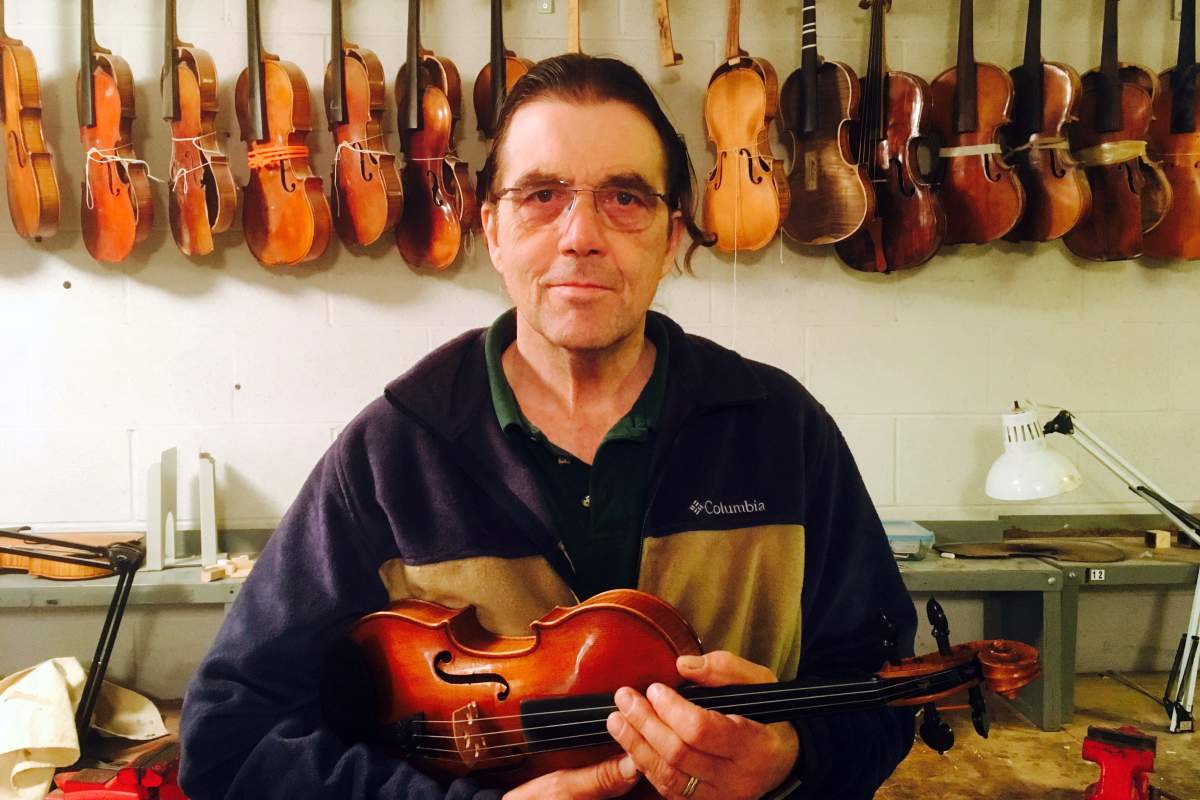
Students learning to play stringed instruments like the violin or cello face familiar challenges as they begin their musical careers, like surviving nerve-wracking auditions and making time for hours of practice. But they also have to keep their instruments well maintained. It can be tough to find someone who knows how to make tiny adjustments that make big differences in sound. But there is one place on the I.U. Campus where students can learn how to repair and even to build stringed instruments.
On the fourth floor of the Music Annex at the Jacobs School of Music, there is a door that looks out of place. It has a sign on it that reads, "String Instrument Laboratory," and stairs leading up to what looks like a wood shop. There's sawdust sprinkled over the ground, and dozens of violins hanging above workbenches, where students work meticulously on pieces of spruce or maple. They've made the trip up to this room to learn the art of creating and repairing stringed instruments from Tom Sparks, Professor of String Instrument Technology.
Sparks has been working in the laboratory as either a student or faculty member for the past four decades. He's adjusted and repaired instruments, and taught students how to build violins and cellos. In addition to his knowledge of string instruments, Sparks has always been a performer, winning several awards for Irish fiddle playing in the 1970s and 80s.
The Jacobs School of Music is one of the few schools in the United States that offers an associate's degree in stringed instrument technology, but it's not a particularly popular program. In fact, there is currently only one student on this degree track. But the shop is always filled with students who enroll in Sparks' violin repair courses, which are open to anyone who needs to fulfill their elective requirements.
Sparks refers to the shop as a one-room schoolhouse, because it includes students of all ages and skill sets, ranging from those who have never cut wood to students like Jackson Maberry, who has made several instruments. "I really sort of had an idea about how to make a violin and had begun a violin before I came here," says Mayberry, "but Tom has really taught me more than anything else how to see in a way that enables a much more refined approach to violin making."
Jim Biggs is another student who has become an experienced woodworker under Sparks' instruction."If you don't have the opportunity to see good violins you can't make a good violin, Biggs says, "So, here, besides whatever teaching you can get from Tom, we have an opportunity to see good instruments. Many of the students at this school have really fine instruments. So, you get to see them and you get to feel them you get an idea of how light they should be. Because you can actually pick up a violin and if it feels heavy to you, you already know it won't be any good."
For hundreds of years, violin making has blurred the lines between craftsmanship and art form. Sometimes it can take a several years to complete one violin. The process includes hundreds of steps, and every centimeter of work can drastically affect the sound of the instrument. And as Sparks suggests, there is no such thing as an ugly violin that sounds good.
"The earliest known violin to date is 1564 and it still goes very well in a Ferrari made yesterday, Sparks says. "It's very fashionable in that car. It's something that has spanned through the decades with no problem of fitting in anywhere. The violin fits in well in a horse and buggy. It fits in well in a Ferrari. It actually fits in extremely well in the space shuttle. So, I can see the violin in the space shuttle kind of sitting next together in their little golden section way. And it'll continue. Violin will continue on into the future. Still being very fashionable. I think any model could use it on any runway and it would be right in their fashion. It would go with any fashion that they were wearing."
Sparks will be retiring at the conclusion of the 2018 spring semester. Upon retirement, Sparks plans to sail around the world with his wife. But when Sparks leaves, he might be leaving behind something special. The skill set he possesses is not all that common anymore with the future of the String Instrument Laboratory and degree program left up to the Jacobs School of Music administration. Sparks mentioned that, before the program started, students had to drive to Chicago to get their violins fixed and that since 1810 the state of Indiana has only had 250 makers of stringed instruments, or luthiers.
"The future of this program is up in the air," Sparks notes. "The program itself, over the years, has been very successful. 95% of the graduating students have left here with jobs. Tt's going to be odd not doing the same thing you've been doing-both as a student and as a faculty member-for my entire life since I was 14. So, this will be my first year off.
"I've enjoyed my work," Sparks adds, "and my work isn't like having a real job. You wake up in the morning and you want to do what you do for a living, I think that's what I do, and a lot of times I'm really excited about the students I have."
"We're very much hoping that the administration will find a replacement for Tom," Says Maberry. "It's not going to be easy to fill those shoes; someone who's an experienced maker and educator of making, as well as a tireless champion for the stringed players at the school."






